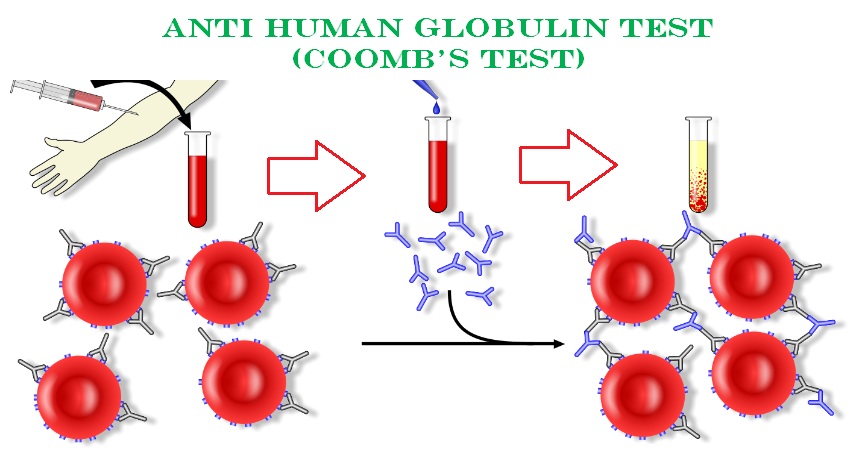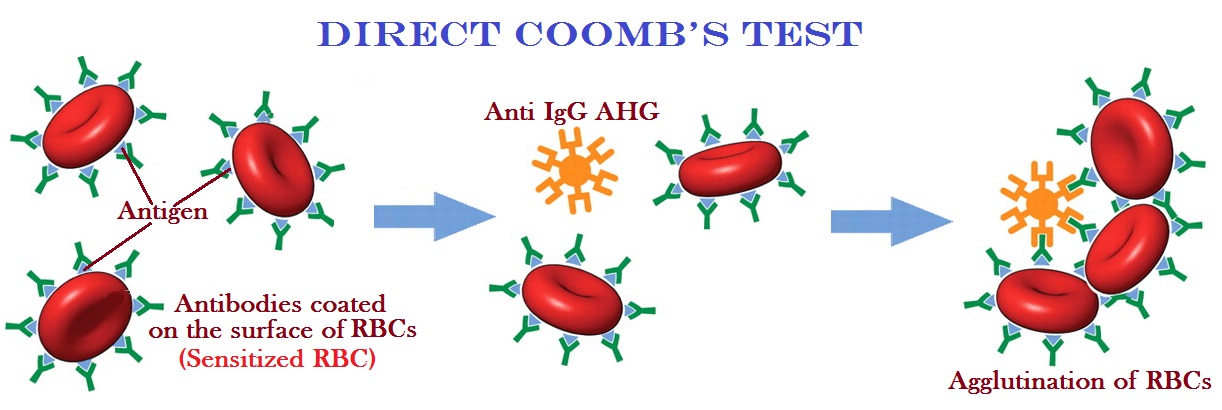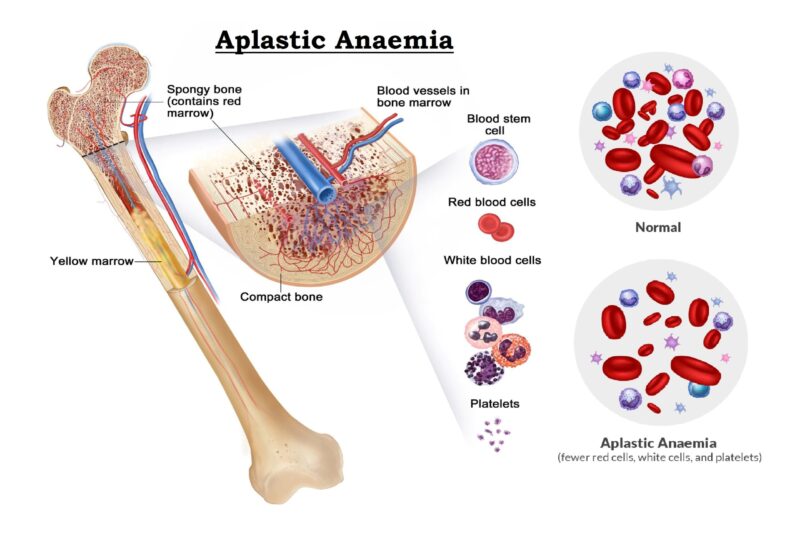Anti Human Globulin Test (Coomb’s Test)
Coomb’s test or Anti Human Globulin test is very useful in recognized weak immunologic reactions. It is widely used in the identification of Du, Compatibility testing, Antibody screening and identification of Sensitized red cells. Anti Human Globulin is made by injecting human globulin in rabbit and purifying the Anti human globulin (AHG) produced by the rabbit. It is commercially available. There are two types of Coomb’s test :
- Direct Coomb’s Test (DCT) or Direct Anti Human Globulin Test (DAT)
- Indirect Coomb’s Test (ICT) or Indirect Anti Human Globulin Test (IAT)

Direct Coomb’s Test (DCT) or Direct Anti Human Globulin Test (DAT)
Direct Coomb’s
Test (DCT) or Direct Anti Human Globulin Test (DAT) is performed to detect
anti-D antibody or other antibodies attached to the Red Blood Cell surface with
in the blood stream. This occurs in the following circumstances :
- When there is a ‘Rh’
Positive baby in the womb of a sensitized ‘Rh’ Negative woman; the antibodies
produced in the mother serum, cross the placenta and after entering the baby’s
blood stream. These antibodies will attach to the baby’s ‘Rh’ positive red
blood cells. These coated (or Sensitized) cells are clumped and removed from
the circulation, causing haemolytic anaemia (Haemolytic Disease of the Newborn;
Erythroblastosis foetalis). - Transfusion Reaction.
- Drug induced red cell
sensitization. - Auto-Immune Haemolytic
Anaemia.
Principle :
Direct Coomb’s Test or Direct Anti Human Globulin Test detects “Sensitized red cells”; where the red blood cells get coated with IgG or globin (anti-D) but do not agglutinate. When the sensitized red blood cells come in contact with Anti Human Globulin reagent they agglutinate.

Method :
Two methods are used for determination of Direct Coomb’s test (DCT) or Direct Anti Human Globulin Test (DAT).
- Tube method
- Gel method
In the developing country
Tube method is commonly performed. But Special circumstances Gel method is
performed. In the Laboratory We performed Tube method.
Requirements :
- Clean
and dry grass free glass test tube. - Pasteur
pipette. - Centrifuge
machine. - Timer
& Marker pen - Microscope
Reagent :
- Anti
Human Globulin (AHG) - Coomb’s
Control Cells (5% ‘O’ Cell Suspension) - Normal
Saline (0.85% NaCl Solution)
Specimen :
Blood drawn into EDTA anticoagulated vial is preferred but oxalated or clotted, citrated whole blood may be used ( the specimen need not to be fasting sample).
Procedure :
- All
the reagents and sample to be brought to the room temperature before performing
the test. - Prepared
5% suspension in isotonic solution of the red cells of patient to be tested. - Taken
a clean and dry glass test tube. Added 1 drop of the pre-paired Red cell
suspension to the test tube by a clean Pasteur pipette. - Washed
the cell suspension three times with normal saline to remove all the trace of
serum. Decant completely after the last washing. - Added
two drops of Anti Human Globulin (AHG). - Mixed
well and centrifuge for 1 minute at 1500 RPM. - Resuspended
the cells by gentle agitation and examine macroscopically or microscopically
for agglutination.
Interpretation :
- Agglutination : Direct Coomb’s test Positive (Patient serum contain Anti-D)
- No Agglutination : Direct Coomb’s test Negative (Patient serum does not contain Anti-D)
Special Note :
- The sensitivity of the test can be increased by incubation at room temperature for 5 to 10 minutes and by recentrifugation.
- All Negative result is cross-checked by adding 1 drop of Coomb’s Control Cells that agglutinate in contact with AHG reagent.
Indirect Coomb’s Test (ICT) or Indirect Anti Human Globulin Test (IAT)
Indirect Coomb’s
Test (ICT) or Indirect Anti Human Globulin Test (IAT) is very important test in
Immunohaematology. This test is performed to detect presence of ‘Rh’ antibodies
or other antibodies in the patient serum in case of following :
- To check whether an ‘Rh’ Negative woman (married to ‘Rh’ Positive husband) has developed Anti-Rh antibody.
- Anti-D may be produced in the blood of any ‘Rh’ Negative persons by exposure to D antigen by :
- Transfusion of ‘Rh’ Positive blood.
- Pregnancy, if the infant is ‘Rh’ positive (if husband is ‘Rh’ Positive)
- Abortion of ‘Rh’ Positive foetus.
Principle :
Indirect Coomb’s test or Indirect Anti Human Globin Test detects Anti-D antibody if present in the patient serum. Known ‘O’ Positive red cells are sensitized by reacting with patient serum (contain anti-D) afterwards these ‘O’ Positive added with Anti Human Globulin reagent. When the sensitized red cells come in contact with Anti Human Globulin (AHG) they agglutinate. If patient serum have anti-D hence after sensitization ‘O’ Positive cells agglutinate with AHG. If patient serum does not have anti-D then ‘O’ Positive cells not agglutinate with AHG.

Method :
Two methods are used for determination of Indirect Coomb’s test (ICT) or Indirect Anti Human Globulin Test (IAT). These are as follows__
- Tube method
- Gel method
In the developing country
Tube method is commonly performed. But Special circumstances Gel method is
performed. In the Laboratory We performed Tube method.
Requirements :
- Clean
and dry grass free glass test tube (10 x 75 mm). - Pasteur
pipette. - Centrifuge
machine. - Microscope
- Incubator
- Timer
& Marker pen
Reagent :
- Anti
Human Globulin (AHG) - Anti-D
Serum (IgG Nature) - Coomb’s
Control Cells (5% ‘O’ Cell Suspension) - Normal
Saline (0.85% NaCl Solution)
Preparation of Coomb’s Control Cells :
Make pooled ‘O’ ‘Rho(D) Positive cells from at least three different ‘O’ Positive blood samples. Washed these cells three times in normal saline (the cells should be completely free from serum with No-free antibodies). Make 5% saline suspension of these cells.
- Mixed
5 drops of well mixed sedimented red blood cells with 2 ml of normal saline. - Centrifuge
at 1500 RPM for 1 to 2 minutes. Discarded supernatant. - Again
added 2 ml of normal saline and mixed well. Centrifuge the tube at 1500RPM for
1 to 2 minutes. Discarded the Supernatant. (this procedure done Three times). - Then
added 4 ml of normal saline with the sedimented red blood cells and mixed well.
(Approximately 5% RBCs suspension)
Specimen :
Fresh Serum Specimen (the
specimen need not to be fasting sample).
Procedure :
- Labelled
three test tube as ‘T’ (Test serum), ‘PC’ (Positive Control), ‘NC’ (Negative
Control). - Added
2 drops of patient serum in the tube labelled as ‘T’. - Added
1 drop of Anti-D in the ‘PC’ labelled test tube and 1 drop of normal saline in
the ‘NC’ labelled test tube. - Added
1 drop of 5% saline suspension of the polled ‘O’ ‘Rho(D) Positive cells in each
tubes. - Incubated
all three test tubes for 45 minutes at 37°C temperature. - Washed
the cells three times in normal saline to remove excess serum with No-free
antibody. (In the case of inadequate washing of the red cells; Negative result
may be obtained). - Added
2 drops of Coomb’s serum (AHG reagent) to each tubes. Keep for 5 minutes and
then centrifuged at 1500 RPM for 1 minute. - Resuspended
the cells and examine macroscopically as well as microscopically.
Interpretation :







Magnificent post, very informative. I wonder why the other experts of this sector don’t notice this. You should continue your writing. I am confident, you have a great readers’ base already!